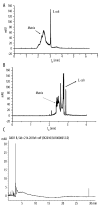The clinical use of a fast screening test based on technology of capillary zone electrophoresis (CZE) for identification of Escherichia coli infection in biological material
- PMID: 21959622
- PMCID: PMC3539466
- DOI: 10.12659/msm.881967
The clinical use of a fast screening test based on technology of capillary zone electrophoresis (CZE) for identification of Escherichia coli infection in biological material
Abstract
Background: Escherichia coli is a Gram-negative bacterium which is a basic, symbiotic element of the physiological flora of the large intestine of humans and warm-blooded animals. However, in specific cases it may become a very dangerous pathogen (eg, diarrhoea, infection of the urinary tract, lungs, and generalized infections). Its early detection, as a cause of infectious disease, helps to achieve optimal treatment results; however, classical microbiological tests require at least 24 hours from sample taking to diagnosis.
Material/methods: We present a unique solution based on CZE technologies enabling identification of E. coli presence in studied sample within half an hour. Altogether, 30 E. coli-infected wounds and ulcerations were examined, comparing the results obtained by classical culture method with the result of capillary zone electrophoresis (CZE) electropherogram.
Results: The method, which does not require any preparation of the sample, achieved 86.7% sensitivity and 85%specificity in the examined clinical material (infections of surgical wounds).
Conclusions: The obtained results enable reliable, very fast testing for E. coli as a pathogen.
Figures





Similar articles
-
Capillary electrophoresis in the diagnosis of surgical site infections.Electrophoresis. 2013 Dec;34(22-23):3206-13. doi: 10.1002/elps.201300263. Epub 2013 Sep 11. Electrophoresis. 2013. PMID: 24037897
-
Rapid identification of Escherichia coli and Helicobacter pylori in biological samples by capillary zone electrophoresis.J Sep Sci. 2006 May;29(8):1180-7. doi: 10.1002/jssc.200500351. J Sep Sci. 2006. PMID: 16830734
-
A study of interactions between bacteria and antibiotics by capillary electrophoresis.Electrophoresis. 2012 Oct;33(19-20):3095-100. doi: 10.1002/elps.201200281. Epub 2012 Sep 20. Electrophoresis. 2012. PMID: 22996999
-
Advances in serum protein electrophoresis.Adv Clin Chem. 2006;42:43-80. doi: 10.1016/s0065-2423(06)42002-3. Adv Clin Chem. 2006. PMID: 17131624 Review.
-
Separation of serum proteins by automated capillary zone electrophoresis.Clin Chem Lab Med. 2003 Jun;41(6):762-72. doi: 10.1515/CCLM.2003.116. Clin Chem Lab Med. 2003. PMID: 12880139 Review.
Cited by
-
A new approach to identifying pathogens, with particular regard to viruses, based on capillary electrophoresis and other analytical techniques.Trends Analyt Chem. 2021 Jun;139:116250. doi: 10.1016/j.trac.2021.116250. Epub 2021 Mar 4. Trends Analyt Chem. 2021. PMID: 34776563 Free PMC article. Review.
-
Capillary Zone Electrophoresis in Tandem with Flow Cytometry in Viability Study of Various ATCC Bacterial Strains under Antibiotic Treatment.Int J Environ Res Public Health. 2022 Feb 6;19(3):1833. doi: 10.3390/ijerph19031833. Int J Environ Res Public Health. 2022. PMID: 35162856 Free PMC article.
-
Determination and Identification of Antibiotic Drugs and Bacterial Strains in Biological Samples.Molecules. 2020 May 31;25(11):2556. doi: 10.3390/molecules25112556. Molecules. 2020. PMID: 32486359 Free PMC article. Review.
References
-
- Stetinova V, Smetanova L, Kvetina J, et al. Caco-2 cell monolayer integrity and effect of probiotic Escherichia coli Nissle 1917 components. Neuro Endocrinol Lett. 2010;31(Suppl 2):51–56. - PubMed
-
- Hrynkiewicz K, Kłodzińska E, Dahm H, et al. Combination of capillary electrophoresis, PCR and physiological assays in differentiation of clinical strains of Staphylococcus ureus. FEMS Microbiol Lett. 2008;286(1):1–8. - PubMed
-
- Jackowski M, Szeliga J, Kłodzińska E, Buszewski B. Application of capillary zone electrophoresis (CZE) to the determination of pathogenic bacteria for medical diagnosis. Anal Bioanal Chem. 2008;391(6):2153–60. - PubMed
-
- Kłodzińiska E, Dahm H, Różycki H, et al. Rapid identification of Escherichia coli and Helicobacter pylori in biological samples by capillary zone electrophoresis. J Sep Sci. 2006;29(8):1180–87. - PubMed
-
- Szumski M, Kłodzińska E, Buszewski B. Separation of microorganisms using electromigration techniques. J Chromatogr A. 2005;1084(1–2):186–93. - PubMed
Publication types
MeSH terms
Substances
LinkOut - more resources
Full Text Sources
Medical

